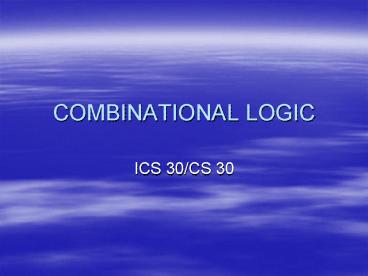COMBINATIONAL LOGIC - PowerPoint PPT Presentation
1 / 16
Title:
COMBINATIONAL LOGIC
Description:
... source; the m output variables go to an external destination. ... A truth table for a combinational circuit consists of input columns and output columns. ... – PowerPoint PPT presentation
Number of Views:37
Avg rating:3.0/5.0
Title: COMBINATIONAL LOGIC
1
COMBINATIONAL LOGIC
- ICS 30/CS 30
2
COMBINATIONAL LOGIC
- Logic circuits for digital systems may be
combinational or sequential. - A combinational circuit consists o logic gates
whose outputs at any time are determined directly
from the present combination of inputs without
regard to previous inputs. - A combinational circuit performs a specific
information-processing operation fully specified
logically by a set of Boolean functions.
3
COMBINATIONAL LOGIC
- Sequential circuits employ memory elements(binary
cells) in addition to logic gates. Their outputs
are a function of the inputs and the state of the
memory elements. The state of memory elements in
turn , is a function of previous inputs. As a
consequence, the outputs of a sequential circuit
depend not only on present inputs, but also on
past inputs, and the circuit behavior must be
specified by a time sequence of inputs and
internal states
4
COMBINATIONAL LOGIC
- A combinational circuit consists of input
variables, logic gates, and output variables. - The logic gates accept signals from the inputs
and generate signals to the outputs. This process
transforms binary information from the given
input data to the required output data. Both
input and output data are represented by binary
signals, I.e., they exist in two possible values,
one representing logic-1 and logic-0.
5
COMBINATIONAL LOGIC
- The n input binary variables come from an
external source the m output variables go to an
external destination.
6
COMBINATIONAL LOGIC
- Design Procedure
- The problem is stated.
- The number of available input variables and
required output variables is determined. - The input and output variables are assigned
letter symbols. - The truth table that defines the required
relationships between inputs and outputs is
derived. - The simplified Boolean function for each output
is obtained. - The logic diagram is drawn.
7
COMBINATIONAL LOGIC
- A truth table for a combinational circuit
consists of input columns and output columns. The
1s and 0s in the input columns are obtained
from the 2n binary combinations available for n
input variables. The binary values for the
outputs are determined from examination of the
stated problem. An output can be equal to either
0 or 1 for every valid input combination. The
output functions specified in the truth table
give the exact definition of the combinational
circuit.
8
COMBINATIONAL LOGIC
- It is important that the verbal specifications
be interpreted correctly into a truth table.
Sometimes the designer must use his intuition and
experience to arrive at the correct
interpretation. Any wrong interpretation which
results in an incorrect truth table produces a
combinational circuit that will not fulfill the
stated requirements.
9
COMBINATIONAL LOGIC
- The output Boolean functions from the truth table
are simplified by any available method, such as
algebraic manipulation or the map method. Usually
there will be a variety of simplified expressions
from which to choose. However, in any particular
application, certain restrictions, limitations,
and criteria will serve as a guide in the process
of choosing a particular algebraic expression .
10
COMBINATIONAL LOGIC
- A practical design method would have to consider
such constraints as - (1)minimum number of gates
- (2)minimum number of inputs to a gate
- (3)minimum propagation time of the signal through
the circuit - (4)minimum number of interconnections
- (5)limitations of the driving capabilities of
each gate
11
COMBINATIONAL LOGIC
- Since all the criteria cannot be satisfied
simultaneously, and since the importance of each
constraint is dictated by the particular
application, it is difficult to make a general
statement as to what constitutes an acceptable
simplification . In most cases the simplification
begins by satisfying an elementary objective,
such as producing a simplified Boolean function
and from that proceeds to meet any other
performance criteria.
12
COMBINATIONAL LOGIC
- Examples
- 1. A combinational circuit has four inputs and
one output. The output is equal to 1 when (1) all
the inputs are equal to 1 or (2) none of the
inputs are equal to 1 or (3) an odd number of
inputs are equal to 1. - Obtain the truth table
- Find the simplified output function in sum of
products. - Find the simplified output function in product of
sums. - Draw the two logic diagrams.
13
COMBINATIONAL LOGIC
- 2. A BCD-to-seven-segment decoder is a
combinational circuit that accepts a decimal
digit in BCD and generates the appropriate
outputs for selection of segments in a display
indicator used for displaying the decimal digit.
The seven outputs of the decoder (a, b, c, d, e,
f, g) select the corresponding segments in the
display as shown in the following figure. The
numeric designation chosen to represent the
decimal digit is shown in
14
COMBINATIONAL LOGIC
- the next figure. Design the BCD-to-seven-segment
decoder circuit.
Segment designation
Numerical designation for display
15
COMBINATIONAL LOGIC
- 3. Design a combinational circuit with four input
lines that represent a decimal digit in BCD and
four output lines that generate the 9s
complement of the input digit. - 4. Figure 1 shows a diagram for an automobile
alarm circuit used to detect certain undesirable
conditions. The three switches are used to
indicate the status of the door by the drivers
seat, the ignition, and the headlights,
respectively. Design the logic circuit with these
three switches as inputs so that the alarm
16
COMBINATIONAL LOGIC
- will be activated whenever either of the
following conditions exists - The headlights are on while the ignition is off.
- The door is open while the ignition is on.
- Fig.1































